平家物語、それは
始まりのための終わり。
魂を鎮める祈りが織りなす物語。
生前の活躍や最期の瞬間
時を越えて現代に語り継がれる命の旅路。

【木曽義仲は振り返る】
あの時振り返ってしまった木曽義仲の、あの時のことを振り返る木曽義仲の物語。平家琵琶の伴奏で平家物語を語る平曲の演奏会です。※この演奏会は言葉の雰囲気を大切にするため現代語訳を少なくしています。
平曲:木曽最期(平家物語巻第九)
最後の五騎にまで追い詰められた木曽義仲。義仲は女武者の巴に早く逃げるよう強く言いますが、巴は立ち去りません。そこに御田八郎師重が現れ、巴は最後の奮戦を見せます。その後、義仲の側に残ったのは今井四郎兼平。義仲はともに討ち死にしようとしますが、兼平は涙ながらに義仲に松原へ向かうよう促しました。松原へ向かう義仲を背に、兼平の最期の戦いが始まります。義仲が自害するまでのわずかな時間を稼ぐため、兼平はただひとり名乗りを上げ、矢を放つのでした。
Synopsis of the Heike Monogatari (Tale of the Heike) “Kisosaigo” in modern Japanese, based on the Heike biwa narrative.
https://morinorijapan.com/tale-of-the-heike/kisosaigo
Kiso Yoshinaka looks back Special Feature Page
https://morinorijapan.com/kisoyoshinaka-lookback-heikebiwa
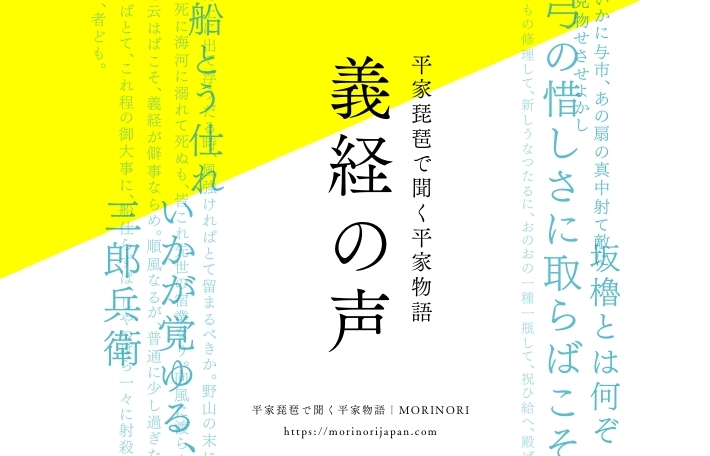
【義経の声】
平家物語に登場する九郎判官義経(源義経)の言葉は、様々な曲節で感情豊かに表現されています。怒る義経、笑う義経。悲しむ義経、脅す義経。平家琵琶の伴奏で語る平家物語で義経の声を聞いてみませんか?平家物語の中から義経が喋っている場面を集めた演奏会です。
ショートパフォーマンス版
平曲:坂櫓・嗣信最期・那須与市・弓流(平家物語巻第十一)
フルパフォーマンス版
平曲:坂櫓・嗣信最期・那須与市・弓流・判官都落
(平家物語巻第十一「坂櫓」「嗣信最期」「那須与市」「弓流」、巻第十ニ「判官都落」)
Summary of the modern translation of “Sakaro”
https://morinorijapan.com/tale-of-the-heike/sakaro
Summary of the Modern Japanese Translation of “Tsuginobusaigo”
https://morinorijapan.com/tale-of-the-heike/tsuginobusaigo
Summary of the modern translation of “NasunoYoichi”
https://morinorijapan.com/tale-of-the-heike/nasunoyoichi
Summary of the modern translation of “Yuminagashi”
https://morinorijapan.com/tale-of-the-heike/yuminagashi
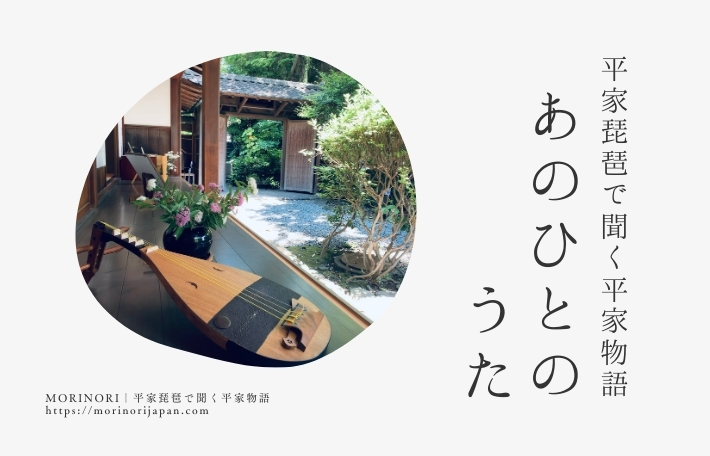
Songs of That Person
This is a small concert in which the parts of the song that symbolize the scene are recited (sung) to the accompaniment of Heike biwa.
平曲:一門都落(平家物語巻第七)
「はかなしな主は雲井に別るれば宿は煙と立上るかな」「故郷を焼野の原とかえりみて末も煙の浪路をぞゆく」
平曲:横笛(平家物語巻第十)
「剃るまでは恨みしかども梓弓まことの道にいるぞうれしき」「剃るとても何か恨みん梓弓引きとどむべき心ならねば」
Yokobue (translation into modern Japanese) Synopsis
https://morinorijapan.com/tale-of-the-heike/yokobue-nachinookinite
平曲:海道下(平家物語巻第十)
「旅の空赤土の小屋のいぶせさに故郷いかに恋しかるらん」「故郷も恋しくもなし旅の空都も終の住家ならねば」
Summary of the modern translation of “Kaidoukudari”
https://morinorijapan.com/tale-of-the-heike/kaidoukudari
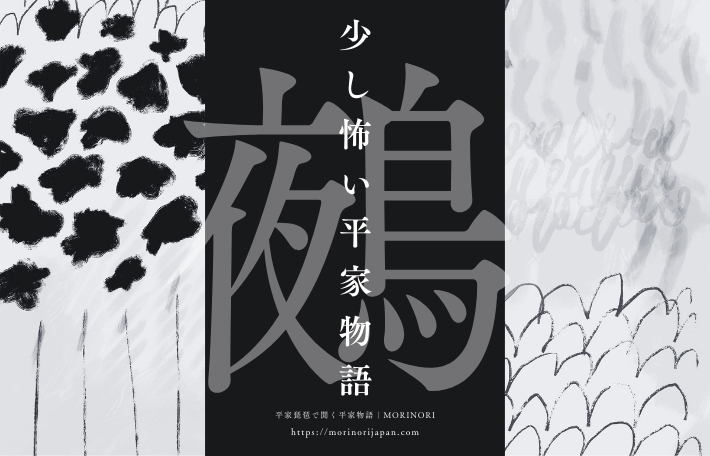
【The Tale of the Heike Listened to by Heike Biwa】
The Tale of the Heike Listened to by Heike Biwa is a small concert in which the strange stories and ghost stories that served as the inspiration for the Tale of the Heike are told with Heike biwa accompaniment. Don’t worry, it’s not scary if you listen to it in the daytime (this concert is held during the day).
Heikyoku: Nue (Tale of the Heike, Volume 4)
During the Nihyou era, there was an incident in which the Emperor Konoe was frightened at night. MinamotonoYorimasa was chosen from among the warriors of both the Minamoto and Taira clans to guard the Emperor, and he waited with his attendant Inosada. At the hour of the ox, a black cloud rose from the forest on the east side of the third street and drifted over the palace, and Yorimasa saw a strange shape in the cloud.
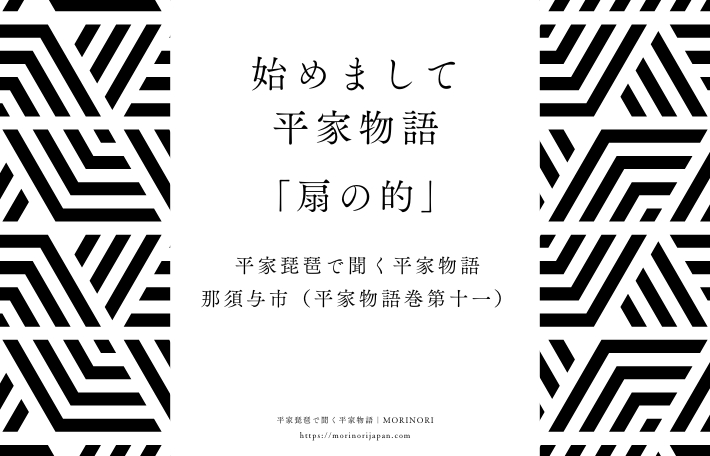
Nice to meet you, Tale of the Heike
You may have studied it a long time ago, you think you saw the characters on the blackboard, it seems to have come up in a test. Why not encounter the Tale of the Heike again? This time, with sound! Let’s go into the world of the Tale of the Heike with Heikyoku (a recitation of the Tale of the Heike accompanied by Heike biwa).
“The Fan Target”
Heikyoku: NasunoYoichi (Tale of the Heike, Volume 11)
During the Genpei War, as the battle was drawing to a close at dusk, a small boat belonging to the Heike appeared. A young woman appeared from the boat and beckoned to them, holding up an open fan at the edge of the boat. At this, the Genji commander-in-chief, Kurohyougan(Yoshitsune), called on the excellent archer NasunoYoichi(Yoichi) and ordered him to shoot the fan down. At first, Yoichi was hesitant about the important task, but he accepted it after following Yoshitsune’s orders. As both the Genji and Heike forces watched on with bated breath, Yoichi prayed to the gods and drew his bow with all his courage.
Summary of the modern translation of “NasunoYoichi”
https://morinorijapan.com/tale-of-the-heike/nasunoyoichi
「敦盛」
平曲:敦盛最期(平家物語巻第九)
源氏の武士、熊谷次郎直実は、一の谷の戦いで敗北し、逃れようとする平家の貴族たちを追いかけて海岸へと向かいました。そこで熊谷は、豪華な武具を身につけた若武者と遭遇します。熊谷は彼を捕らえることに成功しますが、その若武者が自分の息子と同じくらいの年齢であることに気付きます。彼に同情し、その命を救いたいと考えますが、若武者はこれを拒否。背後から迫る味方の手に掛かるよりはと、熊谷は葛藤しながら刀を握るのでした。
Summary of the modern translation of “Atsumorisaigo” (first half)
https://morinorijapan.com/tale-of-the-heike/atsumori-saigo-part1
Atsumorisaigo (The Last Days of Atsumori) – Modern Japanese translation – Summary (2nd half)https://morinorijapan.com/tale-of-the-heike/atsumori-saigo-part2
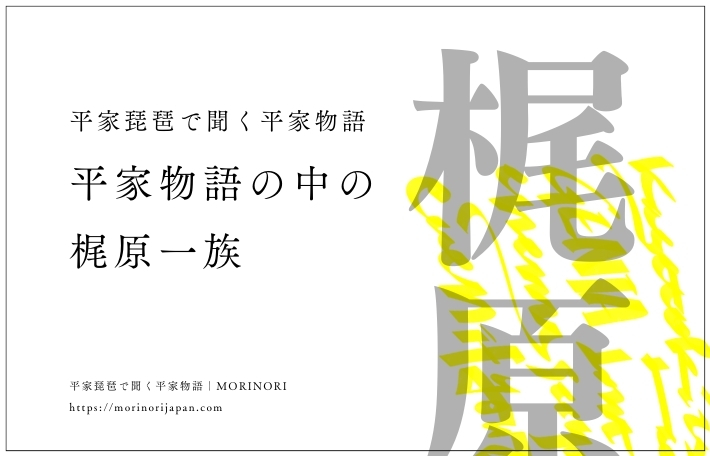
【平家物語の中の梶原一族】
平家物語に登場する梶原一族。景時が長男景季のために戦場に戻る「二度魁(二度之懸)」、佐々木に連れられた生食を見た景季の気持ちが溢れる「生食」、素直に佐々木に騙されてしまう「宇治川先陣」、大切な気持ちがあるからこそ一触即発の「坂櫓」など、応援せずにはいられない梶原一族の物語を集めた演奏会です。
平曲:生食・宇治川先陣・二度魁・坂櫓
(平家物語巻第九「生食」「宇治川先陣」「二度魁」巻十一「坂櫓」)
Summary of the modern translation of “Ikezuki
https://morinorijapan.com/tale-of-the-heike/ikezuki
Summary of the modern translation of “Ujigawanosenjin”
https://morinorijapan.com/tale-of-the-heike/ujigawasenjin
Summary of the Modern Japanese Translation of “Nidonokake”
https://morinorijapan.com/tale-of-the-heike/nidonokake
Summary of the modern translation of “Sakaro”
https://morinorijapan.com/tale-of-the-heike/sakaro
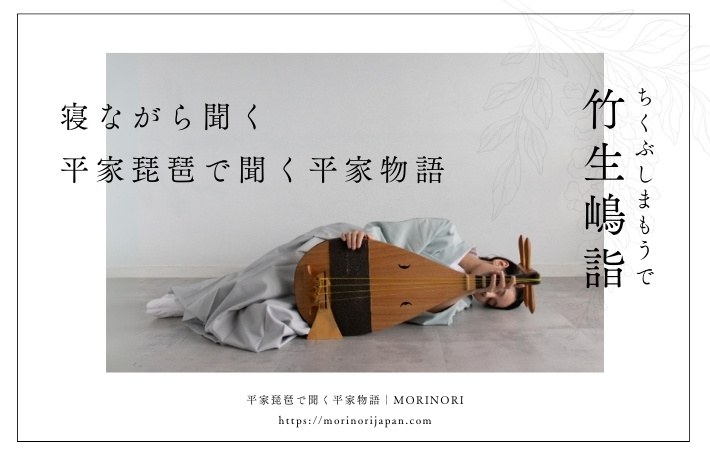
【寝ながら聞く平家琵琶で聞く平家物語】
寝ながら聞く平家琵琶で聞く平家物語は、寝ながら(横になりながら)平家琵琶の伴奏で平家物語を聞いていただく会です。日常を離れて、平家物語の世界に入ってみませんか?難しい言葉や音の響きで眠気を感じるかもしれませんが、そのまま眠ってしまっても構いません。平家琵琶の音色と語り手の声が舞台装置です。物語の風景は皆さんの心の中で創り上げてください。
平曲:竹生嶋詣(平家物語巻第七)
詩歌管弦に長けていた平経正(たいらのつねまさ)は、進軍の途中で訪れた竹生島の美しい自然に深く感動します。経正はこの島が神聖な場所であると感じ、神々への祈りを捧げ、琵琶を演奏するのでした。すると…。お聞きいただきながら経正の心の動きに思いを添わせると、最後に見えない何かが像を結ぶかもしれません。
Special page for the 8th Yokohama Triennale Support Program
https://morinorijapan.com/support-program-8th-yokohama-triennale

【Off the Coast of Nachi】
The Tale of the Heike, Vol. 10: Yokobue and Koremorijusui, are narrated with the accompaniment of the Heike biwa. Each story depicts the liberation from the suffering of this world and spiritual sublimation. Tokiyori and Yokobue’s story achieves spiritual growth and liberation through the form of becoming a priest, and Koremori ends his own life, cutting off his lingering feelings for his family and companions and choosing the path to enlightenment.
Heikyoku: Yokobue (Tale of the Heike, Vol. 10)
Tairano Koremori, with thoughts of his family back in the capital on his mind, heads from Yashima to Koyasan, struggling with his emotions. There he meets Takiguchi Nyudo (Saito Takiguchi Tokiyori), a man who once loved a woman called Yokobue, but who, despite his family’s objections, went on to become a Buddhist priest. This is the story of Yokobue, who inspired Takiguchi Nyudo to turn to Buddhism after seeing the end of the life of Taira no Koremori.
Yokobue – Modern Japanese Translation Synopsis
https://morinorijapan.com/tale-of-the-heike/yokobue-nachinookinite
Heikyoku: Koremori Jyusui (Tale of the Heike, Vol. 10)
After visiting the three Kumano Shrines, Tairano Koremori and his followers head for the sea. When he sees Koremori agonizing over his family before committing suicide, Takiguchi Nyudo wipes away his tears and, feigning composure, tries to talk him out of it. The story depicts Koremori’s final moments, as he cuts off his lingering attachments and chooses the path of enlightenment.
Summary of the Modern Translation of “Koremorijusui”
https://morinorijapan.com/tale-of-the-heike/koremorijusui-nachinookinite
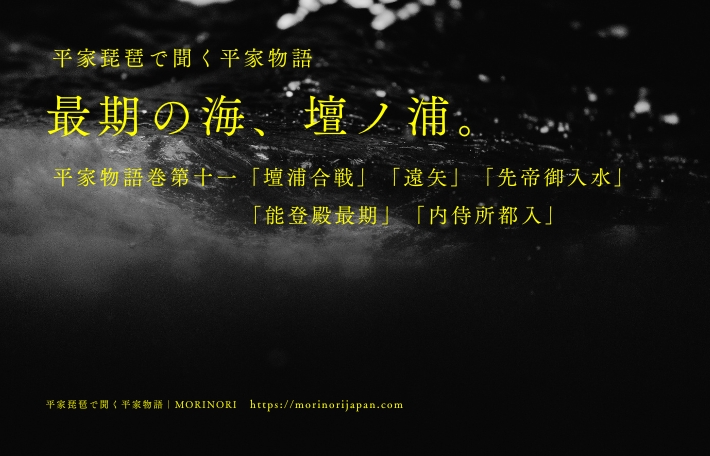
The Final Sea, Dannoura.
The scenery of that day. The voices of that time. I will gather the murmurs that cannot be seen now and tell you about them. The Final Sea, Dannoura.
This is a concert where you can listen to the Tale of the Heike Listened to by Heikyoku (The Tale of the Heike told with Heike biwa accompaniment) related to the Dannoura battle.
Heikyoku: Dannoura Kassen (Heike Monogatari, Vol. 11)
At Dannoura, the Genji and Heike raised battle cries that echoed through heaven and earth. Tairano Tomomori stood on the deck of his ship and encouraged his men, saying, “Even the greatest generals and warriors in Japan, China and India are powerless when their time has come. But their names are precious. Why should we spare our lives? This is the last day for the army.” He encouraged his soldiers.
Summary of the modern translation of ‘The Battle of Dannoura’
https://morinorijapan.com/tale-of-the-heike/dannourakassen
Heikyoku: Touya (Tale of the Heike, Volume 11)
Wadanokotarou Yoshimori of the Genji fires arrow after arrow at the forces of the Heike. Niinokishirou Chikakiyo of the Heike fires back at the Genji, hitting a ship. The soldiers of the Genji and Heike fight each other without sparing their lives, but the Genji cannot lay a hand on them because they have the Emperor Antoku and the three sacred treasures. Then, something like a white cloud drifts through the sky.
‘Touya’ Modern Translation Synopsis
https://morinorijapan.com/tale-of-the-heike/touya
Heikyoku: Senteigojyusui (Tale of the Heike, Volume 11)
The Genji clan one after another suppress the Heike clan’s boats. Tairano Tomomori senses his end and begins to clean the imperial boat. Niinoama says, “Even though I am a woman, I will not fall into the hands of the enemy. I will go with the emperor,” and she proceeds to the sea with the Antoku Emperor in her arms.
Summary of “Senteigojyusui” in modern Japanese
https://morinorijapan.com/tale-of-the-heike/senteigojyusui
Heikyoku: Notodonosaigo (The Tale of the Heike, Volume 11)
As Noritsune did not recognize Yoshitsune’s face, he attacked the warrior, who was wearing splendid armor, one after another. He managed to get on Yoshitsune’s boat, but Yoshitsune jumped to the boat of his allies. Noritsune was unable to pursue him, and threw his weapons and helmet into the sea, spreading his arms out and saying, “Anyone who thinks they can take me on, come and fight me and take me alive.”
Modern translation of the story of “Notodonosaigo”
https://morinorijapan.com/tale-of-the-heike/notodonosaigo
平曲:内侍所都入(平家物語巻第十一)
軍の終わり。海上には赤旗や赤印が切り捨てられ、まるで龍田川の紅葉が嵐で吹き散らされたように。白波は薄紅に染まります。
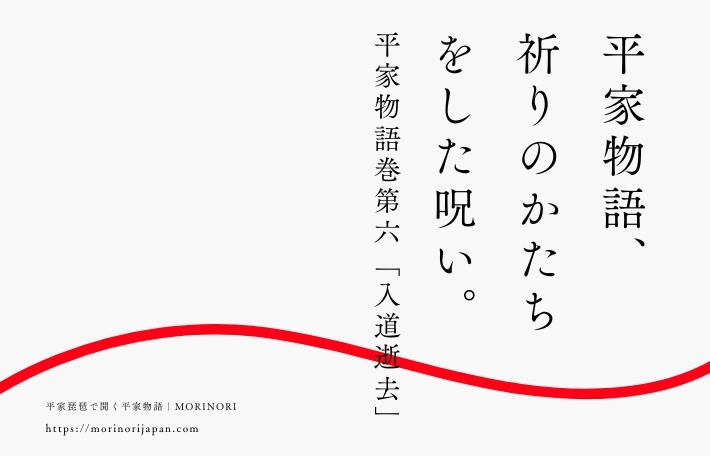
The Tale of the Heike: A curse in the form of a prayer.
The Tale of the Heike is a complex mixture of historical fact and creative writing. The characters in the story are exaggerated and portrayed as unique individuals, as if they are being sewn into the larger flow of the Tale of the Heike. The characters may still be living in a curse in the form of a prayer that will never be undone. The narrator will perform an episode from the Tale of the Heike and Heikyoku (a recitation of the Tale of the Heike accompanied by the Heike biwa).
Heikyoku: Nyuudouseikyo (The Tale of the Heike, Volume 6)
Kiyomori’s condition worsens day by day, and his body is tormented by a high fever, burning like fire. In a dream, Kiyomori’s wife, the Lady of the North, is told that he will be cast into the Avici hell. On his deathbed, Kiyomori said, “There is nothing I regret in this life,” and then continued with his final words, “However, the thing I regret is that the priest did not see Yoritomo’s head during his lifetime.”
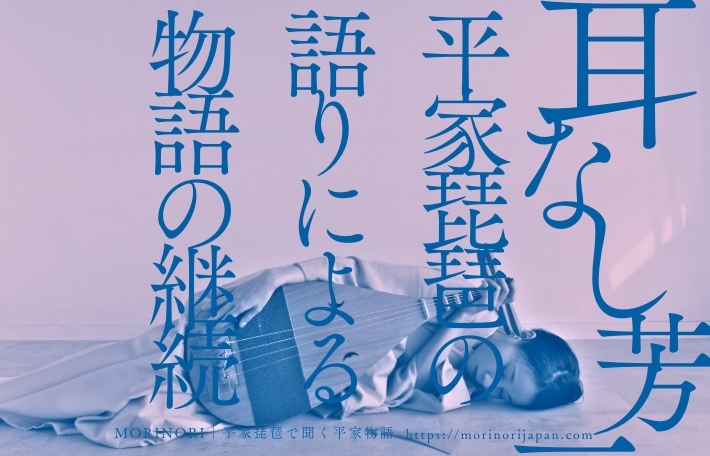
【The Tale of the Earless Hōichi: A Continuation of the Story Told by the Heike Biwa】
This is my story. The ghost story “The Tale of the Earless Hōichi” is said to be based on a Heike biwa minstrel. What if Hōichi had made a different decision that night? This is a one-man show in which the “Battle of Dannoura” depicted in the story is actually narrated on the Heike biwa.
The performance on this page is based on the following sources and has been produced with the following structure and direction.
[Source]
Kanedaichi Haruhiko (1998) “Seishu Bunko Hon Heike Masafusa”, Sanseido Shuppan
【構成・演出】
盛典・株式会社BRIGADE
【耳なし芳一】
原作:耳なし芳一 小泉八雲
脚本・演出:盛典
